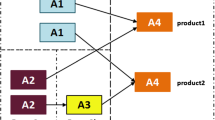Abstract
In this paper, the problem of finding the minimum cost flow line able to produce different products is considered. This problem can be formulated as a shortest path problem on an acyclic di-graph when the machines graph associated with each product family is a chain or a comb. These graphs are relevant in production planning when dealing with pipelined assembly systems. We solve the problem using A * algorithm which can be efficiently exploited when there is a good estimate on the value of an optimal solution. Therefore, we adapt a known bound for the Shortest Common Supersequence problem to our case and show the effectiveness of the approach by presenting an extensive computational experience.
Similar content being viewed by others
References
Agnetis, A., C. Arbib, M. Lucertini, and F. Nicolò. (1995). “Task Assignment and Sub-Assembly Scheduling in Flexible Assembly Lines.” IEEE Transactions on Robotics and Automation, 11, 1–20.
Askin, R.G. and C.R. Standridge. (1993). Modeling and Analysis of Manufacturing Systems. Wiley: New York.
Askin, R.G. and M. Zhou. (1998). “Formation of Independent Flow-Line Cells Based on Operation Requirements and Machine Capabilities.” IIE Transaction, 30, 319–329.
Becker, C. and A. Scholl. (2003). “A Survey on Problems and Methods in Generalized Assembly Line Balancing.” European Journal of Operational Research, 168, 694–715.
Bukchin, J. and M. Tzur. (2000). “Design of Flexible Assembly Line to Minimize Equipment Cost.” IIE Transactions, 32, 585–598.
Fine, C. and R. Freund. (1990). “Optimal Investment in Product-Flexible Manufacturing Capacity.” Management Science, 36, 449–466.
Foulser, D.E., M. Li, and Q. Yang. (1992). “Theory and Algorithms for Plan Merging.” Artificial Intelligence, 57, 143–181.
Fraser, C.B. (1995). Subsequences and Supersequences of String. PhD. Thesis, University of Glasgow, UK.
Fraser, C.B. and R.W. Irving. (1995). “Approximation Algorithms for the Shortest Common Supersequence.” Nordic Journal of Computing, 2, 303–325.
Hart, P.E., N.J. Nilsson, and B. Raphael. (1968). “A Formal Basis for the Heuristic Determination of Minimum Cost Paths.” IEEE Transactions on Systems and Cybernetics, 4, 100–108.
Jiang, T. and M. Li. (1995). “On the Approximation of Shortest Common Supersequences and Longest Common Subsequences.” SIAM Journal on Computing, 24, 1122–1139.
Kimms, A. (2000). “Minimal Investment Budgets for Flow Line Configuration.” IIE Transactions, 32, 287–298.
Lucertini, M. and G. Nicosia. (1997). “On a Generalized Version of the Shortest Common Supersequence Problem.” Technical Report n. 275, Dipartimento di Informatica, Sistemi e Produzione—Centro “Vito Volterra”, Università di Roma “Tor Vergata”.
Maier, D. (1978). “The Complexity of Some Problems on Subsequences and Supersequences.” Journal of ACM, 25, 322–336.
Middendorf, M. (1994). “More on the Complexity of Common Superstring and Supersequence Problems.” Theoretical Computer Science, 125, 205–228.
Nicosia, G. and G. Oriolo. (2003). “An Approximate A * Algorithm and its Application to the SCS Problem.” Theoretical Computer Science, 290, 2021–2029.
Nilsson, N.J. (1971). Problem Solving Methods in Artificial Intelligence. McGraw-Hill: New York.
Pinto, P.A., D.G. Dannenbring, and B.M. Khumawala. (1983). “Assembly Line Balancing with Processing Alternatives: An Application.” Management Science, 29, 817–830.
Räihä, K. and E. Ukkonen. (1981), “The Shortest Common Supersequence Problem Over Binary Alphabet is NP-Complete.” Theoretical Computer Science, 16, 187–198.
Rodeh, M., V.R. Pratt, and S. Even. (1981). “Linear Algorithm for Data Compression via String Matching.” Journal of ACM, 28(1), 16–24.
Timkovskii, V.G. (1990). “Complexity of Common Subsequence and Supersequence Problems and Related Problems.” Cybernetics, 25, 565–580.
Wilhelm, W.E. and R. Gadidov. (2004). “A Branch-and-Cut Approach for a Generic Multiple-Product Assembly-System Design Problem.” INFORMS Journal on Computing, 16, 39–55.
Author information
Authors and Affiliations
Corresponding author
Rights and permissions
About this article
Cite this article
Alfieri, A., Nicosia, G. Minimum cost multi-product flow lines. Ann Oper Res 150, 31–46 (2007). https://doi.org/10.1007/s10479-006-0151-3
Published:
Issue Date:
DOI: https://doi.org/10.1007/s10479-006-0151-3




